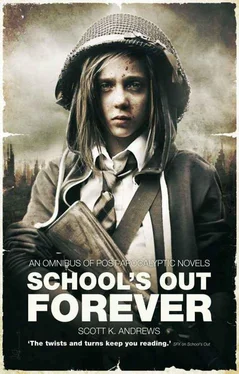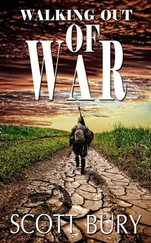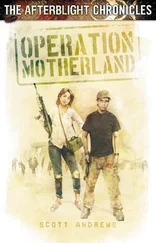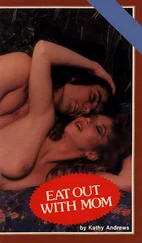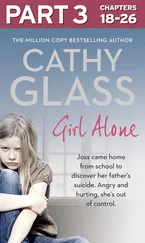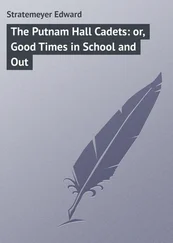The prisoner appeared to think about this for a moment and then replied: “Piss off.”
Mac turned to me and Speight, and beamed. “Finally, fucking finally, I get to torture somebody!”
He turned back and brandished the knife. “Right, you smelly little toerag, I am going to cut you into tiny chunks and feed you to the pigs!”
“Mac, a word,” I said. I was still in Mac’s bad books but he hadn’t demoted me or anything, so I figured I was still persona grata.
“What is it, Nine Lives? I’m busy.” He advanced towards the captive.
“Mac, a moment please,” I insisted. “Outside.”
He turned to look at me. He did not look happy. “This had better be good.”
In the corridor I explained my idea to Mac, who thought about it for a moment and then nodded. Speight scurried off to get the necessary torture implements.
“Does this mean I don’t get to cut him?” said Mac, disappointed.
“You can, yeah, but not now, eh? Just let me do this, we’ll get the info we need, then you can do what you want with him. Fair?”
“All right. This better work though.”
“Trust me.”
Speight returned and handed the tools over to me. I re-entered the room, with Mac and Speight behind me, and I advanced on the bound prisoner. I placed the torture devices on the bedside cabinet, pulled up a chair, and leaned forward to whisper conspiratorially in the captive’s ear.
I told him what I was going to do.
He begged for mercy, but I refused to relent.
I reached into the bowl, pulled out the wet flannel, wrung it out and began to wash the blood from his face.
He screamed.
Not so safe now.
By the time I reached for the shampoo he was telling us everything we wanted to know.
EVERYONE ASSEMBLED IN the briefing room later that evening, in full combats, camouflage on their faces. Guns had already been issued. The thirty-eight remaining boys, remaining officers, myself and Mac gathered together to plan an attack that I felt sure many of us would not survive.
Mac talked us through his plan and I watched as it dawned on the boys exactly how dangerous this night was going to be for them. Rowles looked terrified, Norton was ashen-faced. Defensive fighting is one thing, but to deliberately pick a fight with a heavily armed force entrenched in a near impregnable fortress is quite another. Mac gave it the hard sell, and nobody refused to participate. And to be fair, the plan could work, with a huge truckload of luck.
As the sun fell we marched out the front door and began the three mile yomp to Ightham Mote, determined to rescue our schoolmate and neutralise a threat that could destroy us.
St Mark’s school for boys was going to war.

CHAPTER ELEVEN
THE MAIN ASSEMBLY hall in Castle is full of names. On the wall that used to face the massed school each morning are six large black wooden boards, all hand decorated in blue and gold. The first three list, in chronological order, the Head Boys of the school going back 150 years. The next two list those pupils and teachers from St Mark’s who died in The Great War, and the final one lists the Second World War dead.
But these aren’t the only names in the main hall. The wooden panelling which clads the walls, deep polished and ancient, has been carved on by generations of boys. From the modern graffiti, simple scratches with a compass, to the old, ornate graffiti, with serifed fonts and punctuation, which must have taken hours of patient work with a penknife, boys have left their mark on St Mark’s.
These names tell stories, and one name always fascinated me. James B. Grant carved his name into the wood panel beneath the farthest rear window. It’s a beautiful piece of work, one of the most elaborate signatures in the hall. It must have taken him ages. It reads ‘James B. Grant, 1913.’
His name also appears on the middle board of Head Boys, which tells us that he was Head Boy for the school year 1912-13; he must have carved his name on the wall in his final week at school, unafraid of punishment.
Finally, his is the last name on the board listing the dead of The Great War. He died in 1918.
A whole life story in three names.
There are pictures of the boys St Mark’s sent to war, all dressed up in their corps uniforms. The faded, sepia photographs hang in the corridor that leads to the headmaster’s study, each one with a list of names beneath, telling us who these boys were. There is one photograph, of the school corps from 1912, in which every single one of those names is to be found on the list of war dead. Every single one. Even given the slaughter of those years that’s a remarkable and tragic clean sweep.
James B. Grant sits front and centre in that photograph. He’s wearing puttees and a peaked cap, and he’s got a swagger stick lying across his lap. He looks confident but not serious; there’s a twinkle in his eye and a slight hint of amusement about the lips. He looks like a man who doesn’t take himself too seriously, and I like that about him. He was an officer in the school corps and was doubtless an officer at the front.
When I was much younger I told my dad about this boy, whose name recurred through the fabric of my school. I remember asking him if I’d ever have to go to war, and he said no. He promised me there’d never be another war of conscription, not in my lifetime. The only people who’d go soldiering, he said, were those who’d chosen that life for themselves, like him. I was reassured.
When I had to do a special project for my history GCSE I took Grant as my subject, and I researched his war record. What I discovered horrified me and reinforced my determination that I would never become a soldier, like Grant or my father.
Now I was marching to war like so many boys before me and all I could think about was the tragic fate of James B. Grant.
Because Grant wasn’t killed in action.
He was executed.
THE SUN WAS just edging over the horizon as I ran to cover and peered around the corner of the hedge. The two guards on the west bridge hadn’t seen me. I gestured to the others and, one by one, Mac, Norton, Wolf-Barry, Speight and Patel hurried across to join me. If we could make it across the five metres of open space in front of us then we’d be out of the guards’ line of sight and safe. One of the Blood Hunters’ biggest mistakes was trusting the moat to keep them safe — there were no perimeter patrols at all, just the two sets of guards on the east and west bridges.
Dressed only in a pair of shorts, but daubed all over with shoe polish and carrying a plastic bag with clothes and weapons in it, Mac crawled forward across the lawn until the corner of the building shielded him from the bridge. Then he ran to the stone wall that ringed the moat on the north side. We followed quietly and without incident. There had been a wooden bridge entrance on this side of the house, but it had been knocked down by the Blood Hunters. They thought this side of the house was safe from attack.
Mac clambered over the wall and then climbed down the rough stone. He slid into the moat silently, but we heard him give a tiny gasp at the shock of the cold. He trod water until he was acclimatised and then he turned and swam slowly across the moat to the tiny set of stone steps that led down to the water’s edge from a small door. He climbed out of the water and stood in the doorway. Once there he opened the plastic bag he’d been carrying and popped on a dry shirt and trousers. He also pulled out his gun and machete.
We watched him climb the three narrow steps and peer through the leaded window into what had been the house’s billiard room. There were no lights on, so we couldn’t be sure if anyone was in there or not. He used the machete to force the fragile door until it opened with a splintering crack that I felt sure must have been heard. We all crouched there, frozen, listening for sounds of alarm. Nothing. He pushed the door open and stepped into the room, then turned and waved us across. We were in.
Читать дальше
